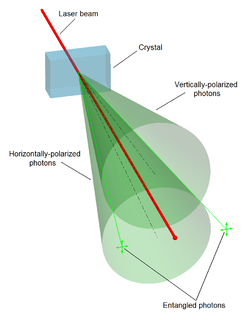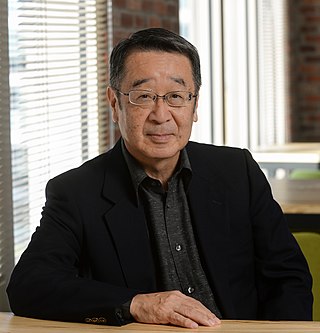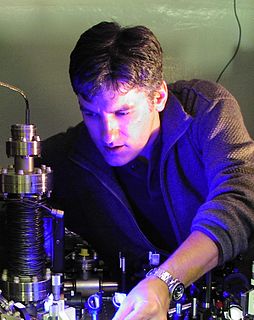This article or section may contain misleading parts.(July 2016) |
This is a timeline of quantum computing .
This article or section may contain misleading parts.(July 2016) |
This is a timeline of quantum computing .
This section needs additional citations for verification .(July 2020) (Learn how and when to remove this template message) |

Quantum computing is the use of quantum-mechanical phenomena such as superposition and entanglement to perform computation. Computers that perform quantum computations are known as quantum computers. Quantum computers are believed to be able to solve certain computational problems, such as integer factorization, substantially faster than classical computers. The study of quantum computing is a subfield of quantum information science.
Quantum teleportation is a process in which quantum information can be transmitted from one location to another, with the help of classical communication and previously shared quantum entanglement between the sending and receiving location. Because it depends on classical communication, which can proceed no faster than the speed of light, it cannot be used for faster-than-light transport or communication of classical bits. While it has proven possible to teleport one or more qubits of information between two (entangled) quanta, this has not yet been achieved between anything larger than molecules.

Quantum entanglement is a physical phenomenon that occurs when a pair or group of particles is generated, interact, or share spatial proximity in a way such that the quantum state of each particle of the pair or group cannot be described independently of the state of the others, including when the particles are separated by a large distance. The topic of quantum entanglement is at the heart of the disparity between classical and quantum physics: entanglement is a primary feature of quantum mechanics lacking in classical mechanics.

A trapped ion quantum computer is one proposed approach to a large-scale quantum computer. Ions, or charged atomic particles, can be confined and suspended in free space using electromagnetic fields. Qubits are stored in stable electronic states of each ion, and quantum information can be transferred through the collective quantized motion of the ions in a shared trap. Lasers are applied to induce coupling between the qubit states or coupling between the internal qubit states and the external motional states.
Quantum networks form an important element of quantum computing and quantum communication systems. Quantum networks facilitate the transmission of information in the form of quantum bits, also called qubits, between physically separated quantum processors. A quantum processor is a small quantum computer being able to perform quantum logic gates on a certain number of qubits. Quantum networks work in a similar way to classical networks. The main difference is that quantum networking, like quantum computing, is better at solving certain problems, such as modeling quantum systems.

D-Wave Systems, Inc. is a Canadian quantum computing company, based in Burnaby, British Columbia, Canada. D-Wave was the world's first company to sell computers to exploit quantum effects in their operation. D-Wave's early customers include Lockheed Martin, University of Southern California, Google/NASA and Los Alamos National Lab.
A quantum bus is a device which can be used to store or transfer information between independent qubits in a quantum computer, or combine two qubits into a superposition. It is the quantum analog of a classical bus.
The one-way or measurement based quantum computer (MBQC) is a method of quantum computing that first prepares an entangled resource state, usually a cluster state or graph state, then performs single qubit measurements on it. It is "one-way" because the resource state is destroyed by the measurements.
In quantum information and quantum computing, a cluster state is a type of highly entangled state of multiple qubits. Cluster states are generated in lattices of qubits with Ising type interactions. A cluster C is a connected subset of a d-dimensional lattice, and a cluster state is a pure state of the qubits located on C. They are different from other types of entangled states such as GHZ states or W states in that it is more difficult to eliminate quantum entanglement in the case of cluster states. Another way of thinking of cluster states is as a particular instance of graph states, where the underlying graph is a connected subset of a d-dimensional lattice. Cluster states are especially useful in the context of the one-way quantum computer. For a comprehensible introduction to the topic see.

Yoshihisa Yamamoto is an applied physicist and the director of Physics & Informatics Laboratories, NTT Research, Inc. He is also Professor (Emeritus) at Stanford University and National Institute of Informatics (Tokyo).

Quantum simulators permit the study of quantum systems that are difficult to study in the laboratory and impossible to model with a supercomputer. In this instance, simulators are special purpose devices designed to provide insight about specific physics problems. Quantum simulators may be contrasted with generally programmable "digital" quantum computers, which would be capable of solving a wider class of quantum problems.
In quantum mechanics, the cat state, named after Schrödinger's cat, is a quantum state that is composed of two diametrically opposed conditions at the same time, such as the possibilities that a cat be alive and dead at the same time. Schrödinger's cat is sometimes connected to the many worlds hypothesis by its proponents.

Christopher Roy Monroe is an American physicist, an experimentalist in the areas of atomic, molecular, and optical physics and quantum information science. He directs one of the leading research efforts in ion traps and quantum optics. Monroe is the Bice Zorn Professor and a Distinguished Professor of Physics at the University of Maryland and Fellow of the Joint Quantum Institute.
Linear Optical Quantum Computing or Linear Optics Quantum Computation (LOQC) is a paradigm of quantum computation, allowing universal quantum computation. LOQC uses photons as information carriers, mainly uses linear optical elements, or optical instruments to process quantum information, and uses photon detectors and quantum memories to detect and store quantum information.
Jean-Michel Raimond is a French physicist working in the field of quantum mechanics.
David P. DiVincenzo is an American theoretical physicist. He is the director of the Institute of Theoretical Nanoelectronics at the Peter Grünberg Institute in Jülich and Professor at the Institute for Quantum Information at RWTH Aachen University. With Daniel Loss, he proposed the Loss-DiVincenzo quantum computer in 1997, which would use electron spins in quantum dots as qubits.
The DiVincenzo criteria are conditions necessary for constructing a quantum computer, conditions proposed in 2000 by the theoretical physicist David P. DiVincenzo, as being those necessary to construct such a computer—a computer first proposed by mathematician Yuri Manin, in 1980, and physicist Richard Feynman, in 1982—as a means to efficiently simulate quantum systems, such as in solving the quantum many-body problem.
In quantum computing, quantum supremacy is the goal of demonstrating that a programmable quantum device can solve a problem that no classical computer can solve in any feasible amount of time. By comparison, the weaker quantum advantage is the demonstration that a quantum device can solve a problem merely faster than classical computers. Conceptually, quantum supremacy involves both the engineering task of building a powerful quantum computer and the computational-complexity-theoretic task of finding a problem that can be solved by that quantum computer and has a superpolynomial speedup over the best known or possible classical algorithm for that task. The term was originally popularized by John Preskill but the concept of a quantum computational advantage, specifically for simulating quantum systems, dates back to Yuri Manin's (1980) and Richard Feynman's (1981) proposals of quantum computing.
In quantum computing, a qubit is a unit of information analogous to a bit in classical computing, but it is affected by quantum mechanical properties such as superposition and entanglement which allow qubits to be in some ways more powerful than classical bits for some tasks. Qubits are used in quantum circuits and quantum algorithms composed of quantum logic gates to solve computational problems, where they are used for input/output and intermediate computations.
In quantum computing, quantum memory is the quantum-mechanical version of ordinary computer memory. Whereas ordinary memory stores information as binary states, quantum memory stores a quantum state for later retrieval. These states hold useful computational information known as qubits. Unlike the classical memory of everyday computers, the states stored in quantum memory can be in a quantum superposition, giving much more practical flexibility in quantum algorithms than classical information storage.
|journal= (help)National Quantum Initiative Act
|journal= (help)_{3}{\mathrm{NH}}_{3}{\mathrm{PbI}}_{3}$ |journal=Physical Review Letters |date=16 April 2020 |volume=124 |issue=15 |pages=157401 |doi=10.1103/PhysRevLett.124.157401 }}